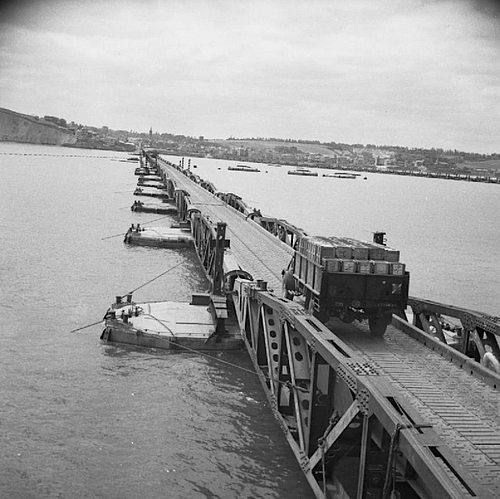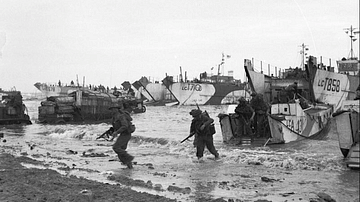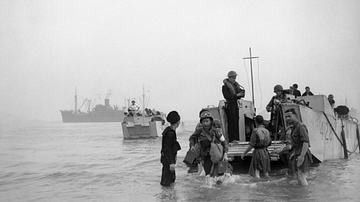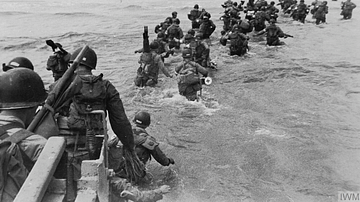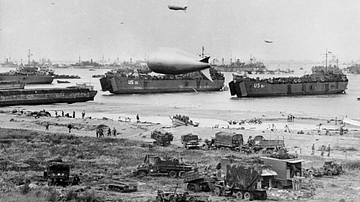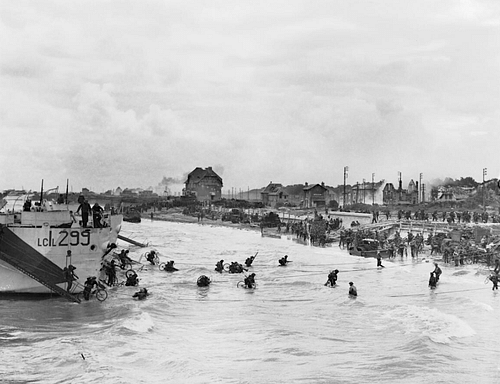
Juno Beach was attacked primarily by forces of the 3rd Canadian Infantry Division as part of the Allied D-Day Normandy landings of 6 June 1944. The Canadian troops initially suffered heavy casualties since aerial and naval bombardments had failed to knock out the heavy guns of the German defensive positions, but by the close of D-Day, the beachhead was secured and deeper than at any other point of the invasion.
Operation Overlord
The amphibious assault on the beaches of Normandy was the first stage of Operation Overlord, which sought to free Western Europe from occupation by Nazi Germany. The supreme commander of the Allied invasion force was General Dwight D. Eisenhower (1890-1969), who had been in charge of the Allied operations in the Mediterranean. The commander-in-chief of the Normandy land forces, 39 divisions in all, was the experienced General Bernard Montgomery (1887-1976). Commanding the air element was Air Chief Marshal Trafford Leigh Mallory (1892-1944) with the naval element commanded by Admiral Bertram Ramsay (1883-1945).
Nazi Germany had long prepared for an Allied invasion, but the German high command was unsure where exactly such an invasion would take place. Allied diversionary strategies added to the uncertainty, but the most likely places remained either the Pas de Calais, the closest point to British shores, or Normandy with its wide flat beaches. The Nazi leader Adolf Hitler (1889-1945) attempted to fortify the entire coast from Spain to the Netherlands with a series of bunkers, pillboxes, artillery batteries, and troops, but this Atlantic Wall, as he called it, was far from being complete in the summer of 1944. In addition, the wall was thin since there was no real depth to any of the defences.
Field Marshal Gerd von Rundstedt (1875-1953), commander-in-chief of the German army in the West, believed it would be impossible to stop an invasion on the coast and so it would be better to hold the bulk of the defensive forces as a mobile reserve to counter-attack against enemy beachheads.
Field Marshal Erwin Rommel (1891-1944), commander of Army Group B, disagreed with Rundstedt and considered it essential to halt any invasion on the beaches themselves. Further, Rommel believed that Allied air superiority meant that movements of reserves would be severely hampered. Hitler agreed with Rommel, and so the defenders were strung out wherever the fortifications were at their weakest. Rommel improved the static defences and added steel anti-tank structures to all the larger beaches. In the end, Rundstedt was given a mobile reserve, but the compromise weakened both plans of defence. The German response would not be helped either by their confused command structure, which meant that Rundstedt could not call on any armour (but Rommel, who reported directly to Hitler, could), and neither commander had any control over the paltry naval and air forces available or the separately controlled coastal batteries. Nevertheless, the defences were bulked up around Normandy to an impressive 31 infantry divisions plus 10 armoured divisions and 7 reserve infantry divisions. The German army had another 13 divisions in other areas of France. A standard German division had a full strength of 15,000 men.
Operation Neptune
Preparation for Overlord occurred right through April and May of 1944 when the Royal Air Force (RAF) and the United States Air Force (USAAF) relentlessly bombed communications and transportation systems in France as well as coastal defences, airfields, industrial targets, and military installations. In total, over 200,000 missions were conducted to weaken as much as possible the Nazi defences ready for the infantry troops about to be involved in the largest troop movement in history. The French Resistance also played their part in preparing the way by blowing up train lines and communication systems that would ensure the German armed forces could not effectively respond to the invasion. Unfortunately for the troops sent to Juno, the Allied bombers failed to knock out a single gun emplacement covering that particular beach.
The Allied fleet of 7,000 vessels of all kinds departed from English south-coast ports such as Falmouth, Plymouth, Poole, Portsmouth, Newhaven, and Harwich. In an operation code-named Neptune, the ships gathered off Portsmouth in a zone called 'Piccadilly Circus' after the busy London road junction and then made their way to Normandy and the assault areas. At the same time, gliders and planes flew to the Cherbourg peninsula in the west and Ouistreham on the eastern edge of the planned landing. Paratroopers of the 82nd and 101st US Airborne Division attacked in the west to try and cut off Cherbourg. At the eastern extremity of the operation, paratroopers of the 6th British Airborne Division aimed to secure the bridges and eastern flank of the invasion.

Juno's Defences
The amphibious attack was set for dawn on 5 June, daylight being a requirement for the necessary air and naval support. Bad weather led to a postponement of 24 hours. Shortly after midnight, the first waves of 23,000 British and American paratroopers landed in France. From 3:00 a.m., air and naval bombardment of the Normandy coast began, letting up just 15 minutes before the first infantry troops landed on the beaches at 6:30 a.m. The area was divided into five beaches, each with its own code name. While US troops attacked Utah Beach and Omaha Beach to the west, Canadian troops landed at Juno Beach and British Army troops launched an assault on Gold Beach and, at the eastern end of the front, on Sword Beach.
Juno Beach stretched from La Rivière to Saint-Aubin-sur-Mer. The beach was divided into three operational sectors (west to east): Love, Mike, and Nan. The defences were impressive here and included mined underwater obstacles, booby-trapped anti-tank structures along the beach, and 20 batteries of 155-mm (6 in) and 75-mm (3 in) guns, although only two of the emplacements were concrete and complete with their roofing. The guns, which covered the beaches comprehensively, were supported by additional fortified bunker positions, all of which were protected by minefields, barbed wire, and trenches. Weaknesses of the German defences were the long gaps between the bunkers, the poor quality of the troops (a mix of inexperienced soldiers, wounded Eastern Front veterans, and conscripted Polish, Georgian, and Russian soldiers), and the general lack of mobility (mobile artillery units still relied on horses to move guns to where they were most needed). Another significant disadvantage to the defenders was their low numbers. There were only 400 troops defending Juno, although they were well dug in. When the Allies came, the first wave alone put 2,400 men on the beach. The German commander of this zone, General Richter, reminded his officers and troops that there was to be no retreat whatsoever; it was do or die for the defenders. In this respect, the barbed wire helped not only to impede the attackers but also kept the conscripted defenders at their posts.
Attacking Juno
The task of taking the beach was given to the 3rd Canadian Infantry Division (under the overall command of the 2nd British Army). These were all volunteers as Canadian conscripts were not obliged to enter battle zones. Their commander was Major-General Rod Keller. The Canadian Army had suffered heavy losses in the infamous failure of the Dieppe Raid (19 August 1942), and it was keen for revenge. Dieppe had shown that amphibious assaults on enemy coastal defensive positions, first and foremost, required strong aerial and naval support; The Canadian force at Juno would get both. Also landed on Juno were units of British commandos and engineers, as well as specialised British tanks and British medical personnel.
The dedicated naval fleet in the waters off Juno included the British cruiser HMS Belfast (the fleet's flagship) and a mix of national navies, which included French, Canadian, and Norwegian destroyers. From 6:00 a.m., this fleet bombarded the shore defences as the landing craft carrying tanks and infantry troops approached the beach. Unfortunately for the Allies, the naval bombardment, which lasted for 90 minutes, destroyed less than 15% of the defenders' gun positions.
The infantrymen in the shallow-bottomed landing craft suffered in the heavy seas and, as soon as the first craft hit the beach at 7:55 a.m. (10 minutes behind schedule), faced murderous shell, mortar, and machine-gun fire from the defenders. Many landing craft became marooned in the shallows as they tried to withdraw after depositing their troops. The tide and rocky shoreline made good timing necessary, and this further exposed the landing craft to enemy fire. The tide was also high (higher than on the previous day as originally planned for the invasion), and this meant many of the mined beach obstacles were invisible under the surface but still lethal. In one wave, 20 out of 24 landing craft were blown out of the water. Smoke bombs were launched on the beach to impede the German gunners.
Private Frederick Perkins describes the assault:
Suddenly we grounded and we were off. Down went the ramp and it was a mad dash for the sand dunes…there were lots of dead Canadians laying about. As they'd hit the beach, beach obstacles were blowing up around them, landing craft were blowing up, hitting the mine obstructions on the beach…It was terrible to see. We dug these hurried bolt holes in the sand and we got in there initially and set up gun positions, anti-tank positions, mortar positions. We were being mortared at the same time and sniped at especially.
(Bailey, 223)
Flail tanks, bulldozers, and sapper units were able to land and clear paths through the rows of beach obstacles. The extensive pre-invasion training had prepared the troops well for the assault, as noted by Sergeant Tom Plumb of the Royal Winnipeg Rifles: "It was identical to the beach we had been training on in Inverness, Scotland, right down to the exact locations of pillboxes" (Ambrose, 136).

The tanks were a surprise to the defenders, as explained here by Sergeant Gariepy:
I was the first tank coming ashore and the Germans started opening up with machine guns. But when we came to a halt on the beach, it was only then that they realized we were a tank when we pulled down the canvas skirt, the flotation gear. Then they saw that we were Shermans.
It was quite amazing. I still remember very vividly some of the machine gunners standing up in their posts looking at us with their mouths wide open. To see tanks coming out of the water shook them rigid.
(Ambrose, 540)
Private Patrick Brown of the Royal Medical Corps describes the situation in his part of Juno Beach:
The Germans were firing mortars when we got on the beach and there was a beachmaster shouting through a loudhailer, 'Keep moving! Get off the beach! Don't clog the beach! Keep within the white tapes!'...We dashed on and starting treating casualties…Some of the cases were rather bad and our major gave them shots of morphine. I had to mark on their forehead, 'M', time, date, and amount. It was so chaotic. It was so chaotic. You only focussed on what was in front of you, really.
(Bailey, 231)
A combination of tanks, engineers with explosives, flamethrowers, and individual acts of heroism steadily knocked out the defensive guns causing so much havoc on the beach. Specialised vehicles (including tanks carrying foldable bridges) helped troops overcome the sea wall. Disabled tanks provided cover for those infantry still coming in from the sea. Armoured bulldozers flattened the barbed wire everywhere, but wrecked tanks were also a cumbersome obstruction to the vehicles landing behind them. The beach became so congested that many wounded men were run over by their own tanks. By noon, the congestion had eased, and the whole Canadian 3rd Division had landed. The troops were now advancing inland, but the defence remained robust.
It took until mid-afternoon to clear residential areas like Courseulles-sur-Mer (the largest town in this combat zone) and Saint-Aubin-sur-Mer where there was house-to-house fighting with the German troops using well their pre-prepared tunnel systems. Gradually, the numbers of men and tanks being constantly landed began to tell, and the beachhead was secured, although as at other beaches, there remained the logistical problem of moving men and equipment off the beach and overcoming serious traffic jams. Locals soon came out to cheer their liberators, throwing roses and opening their wine cellars to distribute the local cider and bottles of calvados.
Moving Inland
As the Canadian troops pushed on inland, they met German defence systems such as the gun battery at Bény-sur-Mer (located inland despite its name), which was only put out of action thanks to a naval bombardment. The delays caused by the heavier-than-expected defences meant that the objective of taking Carpiquet airfield was not achieved. Another failed D-Day objective was to secure the N13 road that led from Bayeux to Caen, but perhaps both the airfield and road objectives were simply too optimistic; events at the other beaches would certainly suggest so.
The German 21 Panzer Division, which had been lurking near Caen, exploited the 3-mile (5 km) gap between Juno and Sword at 4:00 p.m. to make the most decisive counterattack of D-day. Fortunately for the Allies, the British and Canadian troops already had their tanks in motion and plenty of anti-tank guns to deal with this desperate push to keep the Allies on the beaches themselves. Allied air support once again proved crucial as the Canadian Air Force attacked the German tanks. Despite the counterattack and delays on the beaches, the Canadian forces still penetrated deeper into France (about 6 miles / 10 km) than any of the other troops from the other beach landings on this momentous day.
On D-Day, 21,400 troops were landed at Juno with 1,200 casualties of which around 335 were killed. Some historians put the casualty figure at just below 1,000, but it is important to note there are no official figures for D-Day alone. Juno had come under intense fire, just as much as Omaha Beach. For the infantry at Juno, the chances of being either killed or wounded turned out to be something like 1:18, but in the very first waves, this was reduced to a 50:50 chance of surviving enemy fire. On 7 June, the troops on Juno Beach linked with the British forces on Sword Beach. On 8 June, General Montgomery chose the Château de Creully for his command headquarters, located in the Canadian section of the Normandy beachheads. Winston Churchill visited the invasion area on 12 June, landing at Juno, a feat repeated by King George VI of Great Britain (r. 1936-1952) four days later.
The Battle for Normandy
By the end of D-day, 135,000 men had been landed at Normandy, and relatively few casualties were sustained – some 5,000 men. The defenders eventually organised themselves into more substantial counterattacks, deploying their reserves and pulling in troops from other parts of France. This is when French resistance and Allied aerial bombing became crucial, seriously hampering the German commanders' efforts to reinforce the coastal areas of Normandy. Most of the German generals wanted to withdraw, regroup, and then reattack in force, but, on 11 June, Hitler ordered there be no retreat. Operation Neptune officially ended on 30 June. Around 850,000 men, 148,800 vehicles, and 570,000 tons of stores and equipment had been landed since D-Day.
The next phase of Operation Overlord was to push the German army out of Normandy, but this proved more difficult than anticipated, with the defenders fighting resolutely and aided by the broken bocage countryside of fields and hedgerows. There were some serious Allied setbacks such as the staunch defence of Caen and very heavy fighting around Avranches. It was not until August that General Patton and the US Third Army were punching south at the western side of the offensive. The Brittany ports of St. Malo, Brest, and Lorient were taken, and the Allies swept southwards to the Loire River from St Nazaire to Orléans. On 15 August, a major landing took place on the southern coast of France, the French Riviera Landings. On 25 August, Paris was liberated. The northern and southern Allied armies linked up in September and pushed the German army back towards Germany as the Second World War reached its final phase.



